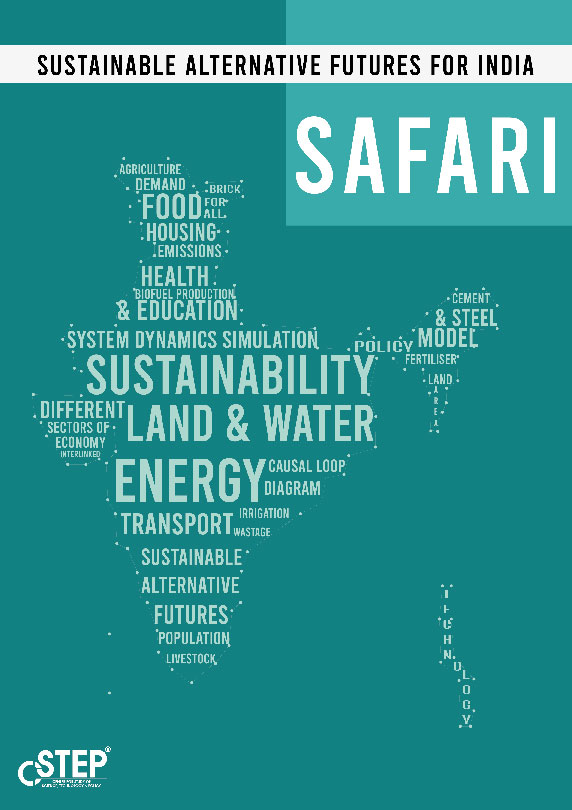Climate change mitigation involves strategies aimed at decreasing greenhouse gas emissions, promoting renewable energy sources, improving energy efficiency, and implementing sustainable practices. CSTEP focuses on building models to simulate India's future across sectors, such as transport, industries, buildings, agriculture, and forestry, to find interventions required to achieve a sustainable and secure future. Our work also involves the study of certain themes that cut across sectors (quality of life and development vs climate action, water and land demands for agriculture vs power, etc).
CSTEP's SAFARI model: Balancing development with climate action requires a good understanding of the interactions between sectors, natural resource systems, and environmental externalities. The Climate Change Mitigation at CSTEP has undertaken a modelling study with the aim to provide such an understanding and help create scenarios for low-carbon development through the use of an interactive simulation tool called Sustainable Alternative Futures for India (SAFARI). You can access the tool here.
SAFARI estimates the energy, emissions, and resources implications of achieving developmental goals such as food, housing, healthcare, education, power for all, and transport up to 2050. The user interface allows you to explore these implications as well as the trade-offs between them. Using SAFARI, you can create integrated scenarios across sectors and test out the impact of policy choices on energy, emissions, and resources. Ultimately, we hope that this tool can be used to provide insights into developing and tracking India's long-term strategy (LTS) in line with the Paris Agreement. For more information, please contact safari@cstep.in



Policy strategies to decarbonise the buildings sector
The Sustainable Alternative Futures for India (SAFARI) model (Kumar et al., 2021) estimates that the buildings sector—directly and indirectly, through its interlinkages with industry and power sectors—accounts for around 30% of India’s annual energy demand and 26% of the nation’s greenhouse gas (GHG) emissions. With the increasing rate of urbanisation and the associated infrastructure development, this is expected to rise further.
India’s need to curb black carbon emissions
At the COP26 climate talks in Glasgow in November 2021, India pledged to achieve net-zero emissions by 2070, positioning itself as a frontrunner in the race to carbon neutrality. According to the Ministry of New and Renewable Energy, India had installed a renewable energy capacity of over 180 GW by 2023 and is expected to meet its target of 500 GW by 2030.
Press Release: Pathways to Steer India's Buildings Sector Towards a Net-Zero Future
New Delhi, 18 March 2024: ‘By 2030, India is expected to be home to 6 megacities with populations above 10 million. Currently, 17% of India’s urban population lives in slums.
Pathways to Steer India’s Buildings Sector Towards a Net-Zero Future
In the face of the global imperative to limit the rise in temperatures to 1.5 °C (above pre-industrial level), as outlined in the Paris Agreement, nations have been striving to transition towards a net-zero economy. This challenge is particularly pronounced for India, where the dual goals of fulfilling developmental aspirations and curbing greenhouse gas (GHG) emissions pose a complex challenge.
Pathways to Steer India’s Buildings Sector Towards a Net-Zero Future
The buildings sector in India is a key contributor to energy demand and greenhouse gas emissions. As most of the buildings that will exist in India in the next 30 years are yet to be constructed, overcoming the challenges posed by the sector will be a deciding factor in India's transition to net zero. Therefore, it is important to explore the different decarbonisation pathways available to achieve India's energy goals.
Beyond shelter, dweller needs within the four walls
In the Interim Budget 2024, Finance Minister Nirmala Sitharaman announced the construction of two crore additional houses over the next five years under the Pradhan Mantri Awas Yojana Gramin (PMAY-G) and the introduction of a new housing scheme for the middle class. This is a commendable step towards realising the goals of the ambitious ‘Housing for All’ initiative and builds on the success of the PMAY scheme, which has facilitated the construction of nearly three crore rural and 80 lakh urban affordable houses since 2015.
Trans-segmental cooperation is the key to implement the renewable energy initiatives announced in the Interim Budget 2024
In a welcome move, the Interim Budget 2024 provides great impetus to the rooftop solar segment through the ‘Pradhanmantri Suryodaya Yojana’. Under this scheme, the current rooftop solar subsidy rate of 40 percent has been increased to 60 percent. Allocation for the solar power sector has seen an increase of 48 percent compared to the last year. At present, India has 11 GW of rooftop solar installations, but the major potential remains untapped.